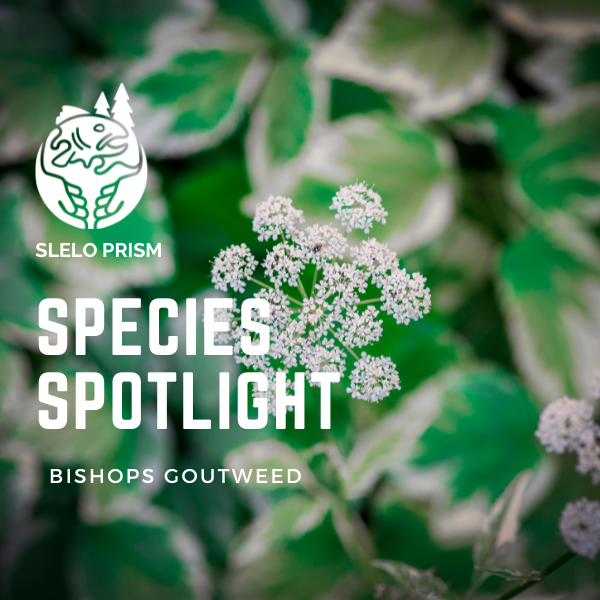This article was featured in the 2024 Winter Newsletter by, Claire Barone-2023 Watercraft Inspection Steward.
Bishop’s goutweed (Aegopodium podagraria ) was introduced to the United States as an ornamental plant throughout the beginning of European settlement. It is a perennial ground cover plant that can thrive in shady dry environments considered less favorable to many other plants. The name “goutweed” originated from its medicinal use for treating gout– which likely lent to its introduction by early settlers. Despite its medicinal purposes, goutweed has become known as an invasive species. Often planted intentionally in gardens, goutweed quickly spreads into natural areas where it outcompetes native ground cover species.
Goutweed gets many of its common names from its outward appearance, such as Snow on the Mountains or Bishop’s Weed. The “snow” is referencing the white, five-petaled flowers that form into an umbel shape on top of tall stems that stand 2-3 feet tall. Goutweed is known as a “triternate” due to the leaves being divided into three groups of three leaflets. The leaves themselves are toothed and lobed, with varying colors of green, hints of blue, and creamy white edges.
Since goutweed has branching networks of rhizomes it spreads aggressively and requires some work to remove it. You can dig up the plants taking care to remove as much of the rhizomes as possible. Place the remains in a thick black plastic bag and let it sit in the sun to “solarize” or bake the plant which helps to make any remains inviable. Mowing is also effective but it will have to be done annually throughout the growing season.
Covering the infested area with a thick landscape fabric/plastic in early spring to remain during at least one full growing season can also aid in suppression. Systemic herbicides can be applied as a foliar spray during the growing season, and are best applied to leafy regrowth after an initial mowing has occurred.
Some native alternatives for goutweed that provide ground cover are, Canada Anemone/wild ginger (Anemone canadensis), big leaf aster (Eurybia macrophylla), pearly everlasting (Anaphalis margaritacea), woodland wild strawberry (Fragaria spp.), Canada mayflower (Maianthemum canadense); some native alternatives that have a similar leaf structure as goutweed are, golden alexander (Zizia aurea) and Virginia waterleaf (Hydrophyllum virginianum). Learn more about native alternatives for goutweed in this factsheet and website.

Please fill out the form below to be added to our listserv and receive our seasonal newsletter, event invitations and other announcements.


